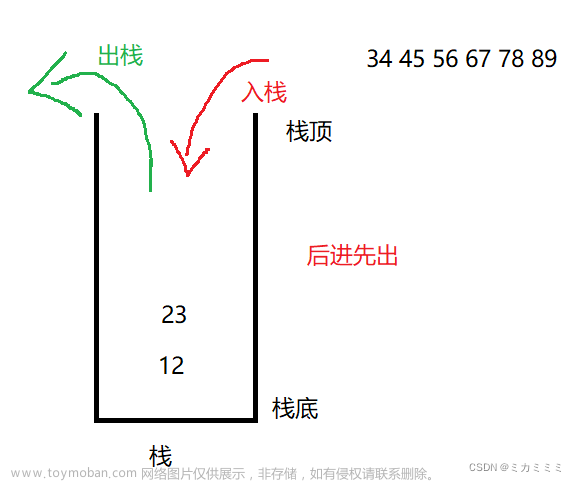前言

栈和队列是一种特殊的线性结构,他与之前学的线性结构不同,栈和队列是拥有一种特殊规则的线性结构,虽然它是用数组或者链表实现,但是只有符合这种规则才能被称作栈或者队列
一、栈
1.栈的概念及定义
栈:一种特殊的线性表,其只允许在固定的一端进行插入和删除元素操作。进行数据插入和删除操作的一端称为栈顶,另一端称为栈底。栈中的数据元素遵守
后进先出LIFO(Last In First Out)的原则。
压栈:栈的插入操作叫做进栈/压栈/入栈,入数据在栈顶。
出栈:栈的删除操作叫做出栈。出数据也在栈顶。

2.栈的实现
栈的实现有两种实现,但是我们可以想想栈的特点,后进先出,我们只对尾部操作,那么是不是用数组刚好合适,虽然用链表也可以,但是数组的尾插的损耗更加小一点,所以我这里就一数组来进行讲解

我这里用动态的数组来实现栈
(1)栈的结构
typedef int STDataType;//方便存储各种数据
typedef struct Stack
{
STDataType* a;
int top;//栈顶位置,如果等于capacity=0时为空
int capacity;//容量
}ST;
(2)StackInit(初始化)
void StackInit(ST* ps)
{
assert(ps);
ps->a = NULL;
ps->top = 0;//初始化时如果top是0,即top指向栈顶上的后一位,所以取出元素时需要减一
ps->capacity = 0;
}
(3)StackPush(压栈)
void StackPush(ST* ps, STDataType x)
{
assert(ps);
if (ps->top == ps->capacity)
{
int newcapacity = ps->capacity == 0 ? 4: ps->capacity * 2;
STDataType* temp = (STDataType * )realloc(ps->a, sizeof(STDataType)*newcapacity);
if (temp == NULL)
{
printf("realloc fail\n");
exit(-1);
}
ps->a = temp;
ps->capacity = newcapacity;
}
ps->a[ps->top] = x;
ps->top++;
}
这里的代码参考动态数组的实现
(4)StackPop(出栈)
void StackPop(ST* ps)
{
assert(ps);
assert(ps->top > 0);
ps->top--;
}
(5)StackTop(取栈顶的元素)
STDataType StackTop(ST* ps)
{
assert(ps);
assert(ps->top > 0);
return ps->a[ps->top - 1];//这里需要减一是因为top指向栈顶上的后一位,如果还不理解就看初始化代码
}
(6)StackEmpty(检查栈是否为空)
布尔类型的数据在c使用需要加stdbool头文件
bool StackEmpty(ST* ps)
{
return ps->top == 0;
}
(7)StackDestroy(销毁栈)
void StackDestroy(ST* ps)
{
assert(ps);
free(ps->a);
ps->a = NULL;
ps->capacity = 0;
ps->top = 0;
}
3.完整代码
(1)头文件
#pragma once
#include<stdio.h>
#include<stdlib.h>
#include<assert.h>
#include<stdbool.h>
typedef int STDataType;
typedef struct Stack
{
STDataType* a;
int top;
int capacity;
}ST;
void StackInit(ST* ps);
void StackDestroy(ST* ps);
void StackPush(ST* ps,STDataType x);
void StackPop(ST* ps);
STDataType StackTop(ST* ps);
bool StackEmpty(ST* ps);
(2)源文件
#include"Stack.h"
void StackInit(ST* ps)
{
assert(ps);
ps->a = NULL;
ps->top = 0;//初始化时如果top是0,即top指向栈顶上的后一位
ps->capacity = 0;
}
void StackDestroy(ST* ps)
{
assert(ps);
free(ps->a);
ps->a = NULL;
ps->capacity = 0;
ps->top = 0;
}
void StackPush(ST* ps, STDataType x)
{
assert(ps);
if (ps->top == ps->capacity)
{
int newcapacity = ps->capacity == 0 ? 4: ps->capacity * 2;
STDataType* temp = (STDataType * )realloc(ps->a, sizeof(STDataType)*newcapacity);
if (temp == NULL)
{
printf("realloc fail\n");
exit(-1);
}
ps->a = temp;
ps->capacity = newcapacity;
}
ps->a[ps->top] = x;
ps->top++;
}
void StackPop(ST* ps)
{
assert(ps);
assert(ps->top > 0);
ps->top--;
}
STDataType StackTop(ST* ps)
{
assert(ps);
assert(ps->top > 0);
return ps->a[ps->top - 1];
}
bool StackEmpty(ST* ps)
{
return ps->top == 0;
}
至此,栈算是搞完了,接下来讲队列
二、队列
1.队列的概念及定义
队列:只允许在一端进行插入数据操作,在另一端进行删除数据操作的特殊线性表,队列具有
先进先出FIFO(First In First Out) 入队列:进行插入操作的一端称为队尾 出队列:进行删除操作的一端称为队头

2.队列的实现

队列需要能够对头和尾操作,所以数组是不好实现的,我们用链表来实现
(1)队列的结构
队列的特点与排队购物差不多,我们要能够控制头的出和尾的进,所以与栈不一样,我们需要头和尾的位置所以我们就要实现成下面的样子
typedef int QDataType;
typedef struct QueueNode//队列的节点
{
struct QueueNode* next;
QDataType data;
}QN;
typedef struct Queue//存储了头和尾,方便我们直接对头和尾操作
{
QN* head;
QN* tail;
}Queue;
此处的实现可以参考我前面的文章链表
(2)QueueInit(初始化)
void QueueInit(Queue* pq)
{
assert(pq);
pq->head = NULL;
pq->tail = NULL;
}
(3)QueuePush(入队)
尾入
void QueuePush(Queue* pq, QDataType x)
{
assert(pq);
QN* newnode = (QN*)malloc(sizeof(QN));
newnode->data = x;
newnode->next = NULL;
if (pq->head == NULL)
{
pq->head = pq->tail = newnode;
}
else
{
pq->tail->next = newnode;
pq->tail = newnode;
}
}
(4)QueuePop(出队)
头出
void QueuePop(Queue* pq)
{
assert(pq);
assert(!QueueEmpty(pq));
QN* next = pq->head->next;
free(pq->head);
pq->head = next;
if (pq->head == NULL)
{
pq->tail = NULL;
}
}
(5)QueueFront(获取头部元素)
QDataType QueueFront(Queue* pq)
{
assert(pq);
assert(!QueueEmpty(pq));
return pq->head->data;
}
(6)QueueBack(获取尾部元素)
QDataType QueueBack(Queue* pq)
{
assert(pq);
assert(!QueueEmpty(pq->tail));
return pq->tail->data;
}
(7)QueueEmpty(检查队列是否为空)
布尔类型需要包括头文件stdbool文章来源:https://www.toymoban.com/news/detail-794159.html
bool QueueEmpty(Queue* pq)
{
assert(pq);
return pq->head == NULL;
}
3.完整代码
(1)头文件
#pragma once
#include<stdio.h>
#include<stdlib.h>
#include<assert.h>
#include<stdbool.h>
typedef int QDataType;
typedef struct QueueNode
{
struct QueueNode* next;
QDataType data;
}QN;
typedef struct Queue
{
QN* head;
QN* tail;
}Queue;
void QueueInit(Queue* pq);
void QueueDestroy(Queue* pq);
void QueuePush(Queue* pq, QDataType x);
void QueuePop(Queue* pq);
QDataType QueueFront(Queue* pq);
QDataType QueueBack(Queue* pq);
int QueueSize(Queue* pq);
bool QueueEmpty(Queue* pq);
(2)源文件
#include"Queue.h"
void QueueInit(Queue* pq)
{
assert(pq);
pq->head = NULL;
pq->tail = NULL;
}
void QueueDestroy(Queue* pq)
{
assert(pq);
QN* cur = pq->head;
while (cur)
{
QN* next = cur->next;
free(cur);
cur = next;
}
}
void QueuePush(Queue* pq, QDataType x)
{
assert(pq);
QN* newnode = (QN*)malloc(sizeof(QN));
newnode->data = x;
newnode->next = NULL;
if (pq->head == NULL)
{
pq->head = pq->tail = newnode;
}
else
{
pq->tail->next = newnode;
pq->tail = newnode;
}
}
void QueuePop(Queue* pq)
{
assert(pq);
assert(!QueueEmpty(pq));
QN* next = pq->head->next;
free(pq->head);
pq->head = next;
if (pq->head == NULL)
{
pq->tail = NULL;
}
}
QDataType QueueFront(Queue* pq)
{
assert(pq);
assert(!QueueEmpty(pq));
return pq->head->data;
}
QDataType QueueBack(Queue* pq)
{
assert(pq);
assert(!QueueEmpty(pq->tail));
return pq->tail->data;
}
bool QueueEmpty(Queue* pq)
{
assert(pq);
return pq->head == NULL;
}
结语
好了,栈和队列算是讲完了,如果有什么不妥之处欢迎指正,谢谢文章来源地址https://www.toymoban.com/news/detail-794159.html
到了这里,关于数据结构之栈与队列详解的文章就介绍完了。如果您还想了解更多内容,请在右上角搜索TOY模板网以前的文章或继续浏览下面的相关文章,希望大家以后多多支持TOY模板网!














